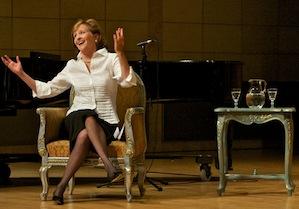Birth of a Curious Chord at Trio Appassionato Preview
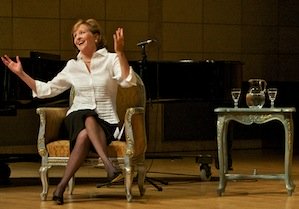
Photos by Betsy Kershner
A nascent, promising theater work about the Schumanns (Robert and Clara) and Brahms made its premiere preview appearance on May 6 in the S.F. Conservatory of Music Concert Hall.
Trio Appassionato (not to be confused with Bulgaria's Appassionata Trio) has regal parentage and two casts of terrific Conservatory graduate student singers. Although virtually unpublicized before its only two performances Sunday-Monday, Trio is clearly heading to a bright future, especially on college campuses.
The show evokes the spirit of 19th century music salons, but its essence is a well-illustrated music-history lecture about the lives of its three subjects. In the distant future, when the show appears on DVD, I'd like to see it follow the example of New Century Chamber Orchestra's On Our Way, providing a viewing option of the whole show or only the musical portions.
Frederica von Stade is narrator and the heart of the work, which originated with Lotfi Mansouri, former general director of San Francisco Opera, and the Conservatory's Richard Harrell. They were joined by Kathryn Cathcart, former music director of Conservatory Opera Theater.
Running 2 1/2 hours, with an intermission, Trio offers Flicka, four singers, and pianists Darryl Cooper and Curt Pajer talk about the eventful — in case of the Schumanns often tragic — lives of the composers.
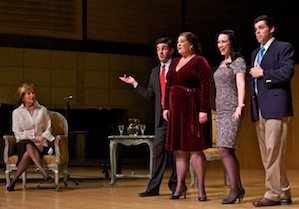
Sunday's student participants, all with impressive performances, were soprano Antonia Tamer, mezzo Raquel Fatiuk, tenor Daniel Bates, and baritone Ryan Bradford. Scheduled for Monday were soprano Yemonja Stanley, mezzo Nicole Jacques, tenor Chris Ramos, baritone Randall Bunell.
Musical portions included songs from Robert Schumann's Dichterliebe, his "Er ist's," "Dein Angesicht," "Tanzlied," and "Traumerei"; Clara Schumann's "O weh des Scheidens, das er tat" and "Die gute Nacht"; songs from Brahms' Ziegeunerlieder and Liebeslieder Walzer (becoming a quintet in the finale of the show), and his "Botschaft" and "Wir wandelten" ... and more.
The show's structure of shared narration — Flicka, the singers, and even the pianists participating in telling the story — is both interesting and risky. As the creators of Trio tried to make the conversation natural and folksy, somehow the result is the exact opposite. Delayed and awkward responses from the singers, trying to sound natural, created instances of cutesy, unintentionally funny moments, taking attention away from the eminently worthwhile "message" of the script.
Flicka, of course, makes it all exactly right, but the others cannot be expected to have her ability to recite the telephone book as gripping drama or charming comedy. I wonder if it was her improvisation or seeming improvisational reading of the text that provided the show's most memorable line. When the audience collectively groaned hearing how the very young, sexually overactive Schumann contracted syphilis from a servant girl, Cooper joined the gasp with a sinister bang on the piano. Flicka's "that was the Syphilis Chord!" brought the house down.
On the other hand, the casual mention that Clara remained free of the disease and the couple went on to have eight children might have benefitted from a parenthesis that the infection remained latent and luckily not transmitted, although later in life it contributed to the dramatic collapse of Robert's health and sanity.
A particularly interesting part of the script deals — however briefly — with Brahms' childhood and his initial contact with the Schumanns. There are many stories here, potentially creating sequels to Trio Appassionato — which is yet to hit the boards in a more public appearance itself.
S.F.-N.Y. Finals in the 2012 Davies Cup
Note the spelling and don't confuse this with tennis' Davis Cup — this one is more important.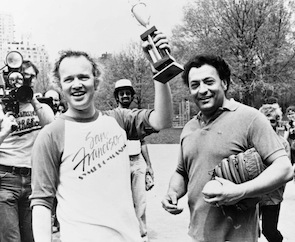
Besides the New York Philharmonic's May 13-14 concerts at Davies Symphony Hall in the American Orchestra Series (see item below), the visiting orchestra will also engage its younger colleague in an important softball game. (About the age reference: against SFS' centennial celebration, Mahler's old orchestra in New York has been around since 1842.)
Ever since the S.F. Symphomaniacs overcame the N.Y. Philharmonic Penguins 11-6 in 1983 — see photo for proof — the New York team, now rejuvenated under the leadership of Alan Gilbert, 45, has been looking for a comeback. This is their chance, especially considering MTT's eligibility for senior fare on MUNI.
The game, free and open to all — but with limited seating — will begin at 11 a.m. on Sunday, at Lazzeri Field, Jackson Playground, 17th and Carolina streets, in San Francisco's Potrero Hill neighborhood. The field is named after native San Franciscan major leaguer Tony Lazzeri, who played for the New York Giants.
And now the full, ugly truth: The first match, in 1981, also with de Waart vs. Mehta, had lousy pitching on both sides, but the San Franciscans were trashed 24-16. Ouch. Symphony benefactor Louise M. Davies reluctantly presented the Davies Cup to the opponents herself.
Somewhat off-topic, but interesting — the press release from SFS has this (new-to-me) information: "Emirates is the Official Airline of the San Francisco Symphony." That's a long way to go for a sponsor.
N.Y. Philharmonic's New Commission Coming to Davies Hall
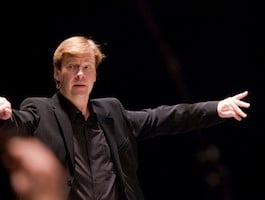
When it's the New York Philharmonic's turn to celebrate the San Francisco Symphony centennial in Davies Hall, May 13-14, the featured new work will be a concerto by Magnus Lindberg.
The work had its world premiere last week in Philharmonic Hall, and The Financial Times' Martin Bernheimer was there:
... the central attraction, literally and figuratively, involved the world premiere of Magnus Lindberg’s Piano Concerto No. 2. A co-commission with the Concertgebouw and the Gothenburg Symphony, this adventure marks the final installment of Lindberg’s tenure here as composer in residence.In an unabashedly hyperbolic annotation, the conductor hailed and farewelled Lindberg as "one of the great composers." After the 33-minute opus surged to its ultimate thumping climax, the audience responded with instant cheers and a semi-standing ovation. Rightly, the celebrated Finnish composer, 54 next month, shared his kudos with the virtuoso pianist Yefim Bronfman. Everyone — well, nearly everyone — seemed happy.
The concerto, which spans three connected, ultra-convoluted movements, demonstrates Lindberg’s now-conventional inclinations. Unlike his (in)famous Kraft (1985), which utilised "found objects" such as car springs and chair legs, the current challenge reverts to virtually the same tame orchestra that Ravel used 82 years ago for his Concerto for Left Hand.
Lindberg writes that his showpiece contains "some brutal music, like that in Kraft, as well as very detailed and lyrical music." This listener heard the brutality, also the detail, but he missed the lyricism. Lofty intentions notwithstanding, the work suggests a bombastic jumble, oddly focused, unrelentingly violent and melodically deprived. Bronfman, unfazed by the unreasonably cruel technical demands, played the knuckle-busting solos, crashing cadenza and all, with percussive force and boundless energy. One didn’t have to admire the vehicle to celebrate the driver.
S.F. International Arts Festival Opens
Check the event-packed schedule for the San Francisco International Arts Festival, running through May 20.Note just this week the May 10-11 performances by Japan's Mansaku-no Kai; the May 10 appearance of the Earplay Ensemble, with Melody of China; May 11 concert by singer/songwriter Hélène Renaut; May 12-13 the AXIS Dance Company, and many more.
Nemmers Prize to Kernis
San Francisco Conservatory of Music alumn, Pulitzer Prize-winning composer Aaron Jay Kernis has been selected as the 2012 winner of the Michael Ludwig Nemmers Prize in Music Composition at the Bienen School of Music at Northwestern University.Previous recipients of the Nemmers Prize, which is given for "outstanding achievement in music," were John Adams, Oliver Knussen, Kaija Saariaho, and John Luther Adams. "I am thrilled and deeply grateful to receive the Nemmers Prize," Kernis said, "and I thank the jury for this honor, which so generously recognizes a life's work of composing. It is indescribably gratifying to sense that one's dedication to creating new music can be meaningful to other people's lives, and extend communication among us. I have had many memorable experiences with Chicago's music groups in recent years; the area is becoming a center for the highest standards of new music performance and idea. It will be a great pleasure to work with the young musicians and faculty at the renowned Beinen School at Northwestern, and deeply exciting to have my work performed again by the Chicago Symphony."
The Coming Upgrade of Your 5 Mbps Download ... to 922 Mbps
Internet service these days comes in medium or fast flavors, with very few "dial-up" customers to be found anywhere. And yet, the U.S. average download of 5 megabits per second ranks 26th globally. An amazing, sorry fact about the former "world leader of technology," and bad news for those of us watching concerts and opera online.There is hope, however, in the long run, according to a report on Google Fiber:
In 2010 the company announced plans to bring super-high-speed Internet access to select communities in America and in 2011 picked Kansas City to start. The search giant has said it hopes to spur innovation among cable companies and Internet service providers by demonstrating what’s possible with Internet speeds 100 times faster than the U.S. average.Google has already strung more than 100 miles of fiber-optic cable along utility poles, and expects to connect its first homes in the next few months. Its test network of about 850 homes in a faculty neighborhood near Stanford University in Palo Alto, CA, already provides blistering download speeds of 922 megabits per second and upload speeds of 883 Mbps. At those speeds, Web surfers — or pirates — can download a DVD in under a minute or a high-definition Blu-ray in five.
Avedis Season-Closer: Quantz, Damase, Martinů, Et Aliae
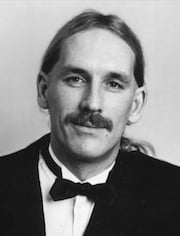
The 2012 Avedis Chamber Music Series season is coming to an end on May 20, with a 2 p.m. matinee, at the Legion of Honor. Tickets ($16-$22) include admission to the museum's permanent collection, and parking is free. Yet, beyond those practical considerations, there are important artistic reasons to consider.
The musicians are Alexandra Hawley, flute; Roy Malan, violin; and Robin Sutherland, piano. The program is way out of the box: trios by Johann Joachim Quantz and Jean-Michel Damase, Jacques Ibert's Deux Interludes, Francis Poulenc's Sonata for Flute and Piano, Bohuslav Martinů's Sonata for Flute, Violin, and Piano.
French composers Damase, Ibert, and Poulenc constitute the core of the final program. They are joined by Bach-contemporary Quantz, and a neoclassical work by the Czech Martinů.
Perhaps the least known composer on the program is Damase. He was born in Bordeaux in 1928, studied with Dupré, and received the Prix de Rome. His career as a pianist overshadowed his compositions, but the Trio has been well regarded. The piece was originally written for flute, oboe, and piano; the composer allowed the substitution of violin for oboe.
Anne Girardot wrote that "the melodies flow from Damase's pen as if from the trees that line the Champs Elysées, and sway in a gentle Parisian breeze. The music conjures up a stroll in the square of Saint-Sulpice, with its church, detached and calm. The finale reminds us of Montparnasse, playground of artists and musicians, with its many cafés. The music, from first note to last, is utterly French and always memorable."
Says Sutherland:
Ransom Wilson and I championed this delightful work in America back in the early '80s. It is, in the words of its composer, "Musique de la brasserie," and, indeed, much of Damase's music can be categorized thus. He is without question the heir to Poulenc, and an early work, the cantata Et la belle se reveilla, captured the Prix de Rome — more than can be said for Maurice Ravel.
Barbary Coast Comes Alive in Davies Hall
At age 100, a sense of history and a bit of nostalgia are not unexpected. San Francisco Symphony, in its centennial season, will reach back to Barbary Coast days.
The small Wild West town of San Francisco in the 1850s had symphonic music and opera before paved roads or indoor plumbing. It also had a famous nine-block red-light district around Broadway, called the Barbary Coast, named after a pirate-ridden area off the coast of North Africa.

The orchestra is honoring the city's musical heritage with a series of concerts called "Barbary Coast & Beyond: Music from the Gold Rush to the Panama-Pacific Exposition." The fair, announcing to the world that San Francisco had recovered from the Great Quake, was held in 1915.
These will be unusual concerts, staged by James Robinson, and featuring video design by Jeffrey Teeter, recreating the atmosphere of the old days. Besides the orchestra and soloists, participants include the United States Air Force Band of the Golden West, and former Beach Blanket Babylon star Val Diamond as narrator. Conductor Michael Tilson Thomas is responsible for the concept and text.
Soprano Laura Claycomb will sing arias made popular in Barbary Coast days by such great divas as Luisa Tetrazzini. Violinist Vadim Gluzman performs music from a Henryk Wieniawski concerto popular during the Gold Rush, and pianist Anton Nel is to be heard in Gottschalk’s Grand Tarantelle.
The orchestra is joined by organist Cameron Carpenter in Hail! California, a sonic blockbuster composed by Camille Saint-Saëns for the Panama-Pacific Exposition.
The video portion of the concerts highlight famous artists of the period performing in San Francisco, such as actor Edwin Booth (brother of John Wilkes Booth), who brought Shakespeare to California beginning in the 1860s; American pianist-composer Louis Moreau Gottschalk; opera singer Adelina Patti, and violinists Ole Bull and Henryk Wieniawski.
Bjoerling For Free
The great tenor Jussi Bjoerling (1911-1960) made relatively few studio recordings, but they are now all in public domain and on-line for free.From the 1920 "Der Gottesacker" by Beneken, through the 1960 Lehár "Dein ist mein ganzes herz," it's all there for the clicking.
Start with the "Ingemisco" from the Verdi Requiem.
S.F. Opera Cinema Here and Over There
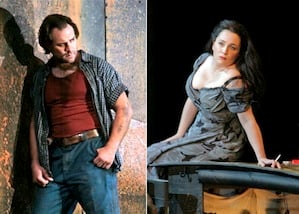
Photo by Cory Weaver
Unlike the expensive Met HD screenings, SFO tickets run from $9 to $11.50. (And, on the adults-only balcony section, alcoholic beverage may be purchased and brought into the theater; how apropos for Traviata's "Libiamo"!)
Meanwhile, General Director David Gockley is planning to re-launch San Francisco's HD program next year. In an interview with Richard Scheinin in the Mercury News, Gockley said his first initial attempt four years ago didn't go well:
... to follow the Metropolitan Opera into the HD broadcasting business, San Francisco Opera cut a deal with a distributor called The Bigger Picture to digitally stream some of its War Memorial Opera House performances to movie theaters. But "the theater chains ended up being mostly in very, very remote suburban areas in multiplexes, and there was no real promotion done, no real marketing. We didn't attract enough attendance in those venues to make it worth our while.The new plan for 2013:"We were so eager to jump on that bandwagon, the new digital-distribution bandwagon, that we didn't realize that the (theater chains) the Met already had tied up were really the ones in areas of towns and other locations that were the most likely to deliver the audiences. Also, the Met went 'live' at the same time as their Saturday radio broadcasts, so they already had a built-in audience for that time of the day.
"We should have rolled it out much more slowly, and built much more of a brand demand for what we did, to get in better locations," Gockley says. "You live and learn."
"We're going to establish ourselves abroad, in Europe. And our distributor — it's called Rising Alternative — they have about 450 theaters worldwide, and we will be going to them, with two or three titles to start. They have opened up Europe, and then Latin America and Asia. We look to the time when they are up to 1,000 venues, and then the money becomes substantial enough. So then you're bringing back at least a portion of what it costs to put out this stuff."Once you've gone to international cinema," he explains, "it makes DVD easier; it makes subsequent airings on European television easier."
Additionally, he says, the company plans to focus on branding itself in the western U.S. through broadcasts on KQED-TV (with which it has an ongoing partnership) and "about five" other PBS affiliates in western states. "We're looking for a more regional presence, while establishing ourselves abroad, and we're going to stick to it," Gockley says.
"We know we want to do The Tales of Hoffman live around the world in June of 2013," he says. That's the month it opens at War Memorial with soprano Natalie Dessay leading the cast. "But we're hoping to get a couple of our fall productions in there, as well."

